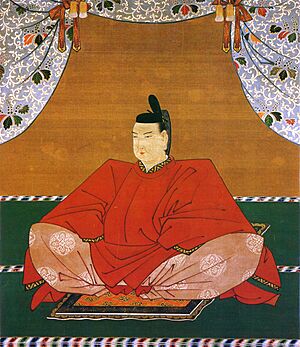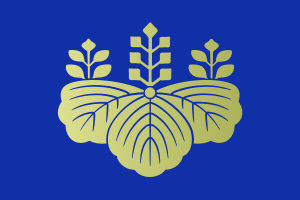Emperor Ichijō facts for kids
Quick facts for kids Emperor Ichijō一条天皇 |
|||||
|---|---|---|---|---|---|
 |
|||||
| Emperor of Japan | |||||
| Reign | July 31, 986 – July 16, 1011 | ||||
| Coronation | August 1, 986 | ||||
| Predecessor | Kazan | ||||
| Successor | Sanjō | ||||
| Born | July 15, 980 Heian Kyō (Kyōto) |
||||
| Died | July 25, 1011 (aged 31) Heian Kyō (Kyōto) |
||||
| Burial | En'yū-ji no kita no misasagi (圓蝠寺北陵) (Kyoto) | ||||
| Spouse | |||||
| Issue |
|
||||
|
|||||
| House | Yamato | ||||
| Father | Emperor En'yū | ||||
| Mother | Fujiwara no Senshi | ||||
Emperor Ichijō (一条天皇 (Ichijō-tennō)) was the 66th emperor of Japan. He ruled from 986 to 1011.
He was born on July 15, 980, and passed away on July 25, 1011. His personal name was Kanehito (懐仁). He was the first son of Emperor En'yū and Fujiwara no Senshi.
Contents
Becoming Emperor: A Young Ruler's Start
Ichijō became emperor when he was only six years old. This happened after Emperor Kazan gave up his throne in 986. Ichijō's rule took place during the Heian period, a time when Japanese culture was at its peak.
His reign also saw the Fujiwara clan become very powerful. Before Ichijō, there was some political trouble within the Fujiwara family. This led to three emperors leaving the throne early.
From the start, young Emperor Ichijō was guided by his uncle, Fujiwara no Michinaga. Michinaga became very influential in 995 after his older brothers passed away.
Important Dates During Ichijō's Reign
- August 1, 986: Emperor Ichijō officially became emperor.
- March 1, 991: His father, former-Emperor En'yū, passed away at age 33.
- 1008: Former-Emperor Kazan passed away at age 41.
- July 16, 1011: After 25 years as emperor, Ichijō gave up his throne. His cousin, who became Emperor Sanjō, took over.
- July 19, 1011: Emperor Ichijō became a Buddhist monk.
- July 25, 1011: Emperor Ichijō passed away.
Imperial Family and Influential Women
Emperor Ichijō had two main empresses. The first was Fujiwara no Teishi (also known as Sadako). She was the daughter of Fujiwara no Michitaka.
His second empress was Empress Shōshi (also known as Akiko). She was the daughter of Fujiwara no Michinaga, who was Michitaka's younger brother. It was unusual to have two empresses at the same time. However, Michinaga argued that the titles for empresses were different, so two women could hold them.
Both empresses had courts that were famous for their culture and learning.
- Sei Shōnagon, who wrote The Pillow Book, worked for Empress Teishi.
- Murasaki Shikibu, who wrote The Tale of Genji, worked for Empress Shōshi.
These women were very talented writers and poets.
Ichijō loved literature and music, especially the flute. Because of this, important court members encouraged their daughters to host cultural gatherings. Emperor Ichijō was known for being calm and was well-liked by his people.
Ichijō's Children
Emperor Ichijō had five children:
- With Empress Teishi:
- Princess Shushi (997–1049)
- Prince Atsuyasu (999–1019)
- Princess Bishi (1001–1008)
- With Empress Shōshi:
- Prince Atsuhira, who later became Emperor Go-Ichijō
- Prince Atsunaga, who later became Emperor Go-Suzaku
Imperial Visits and Burial Place
During Ichijō's rule, emperors began visiting four important shrines: Kasuga, Ōharano, Matsunoo, and Kitano. Later, emperors also visited Kamo, Iwashimizu, and Hirano every year.
Emperor Ichijō's burial place is known. He is honored at a memorial Shinto shrine in Kyoto, called En'yū-ji no kita no misasagi.
He is buried among the "Seven Imperial Tombs" at Ryōan-ji Temple in Kyoto. His tomb is called Kinugasa-yama. These tombs were restored in the 19th century by Emperor Meiji.

Eras During Ichijō's Reign
In Japan, years are also named after different eras. Here are the era names during Emperor Ichijō's rule:
- Eien (987–988)
- Eiso (988–990)
- Shōryaku (990–995)
- Chōtoku (995–999)
- Chōhō (999–1004)
- Kankō (1004–1012)
See also
| Regnal titles | ||
|---|---|---|
| Preceded by Emperor Kazan |
Emperor of Japan: Ichijō 986–1011 |
Succeeded by Emperor Sanjō |

